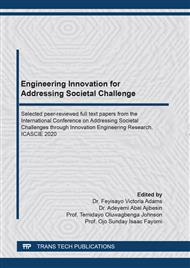[1]
G. Hu, K.H. Smith, N.J. Nicholas, J. Yong, S.E. Kentish, G.W. Stevens, Enzymatic carbon dioxide capture using a thermally stable carbonic anhydrase as a promoter in potassium carbonate solvents, Chemical Engineering Journal 307 (2017) 49-55.
DOI: 10.1016/j.cej.2016.08.064
Google Scholar
[2]
F.A. Rahman, M.M.A. Aziz, R. Saidur, W.A.W.A. Bakar, M.R. Hainin, R. Putrajaya, N.A. Hassan, Pollution to solution: Capture and sequestration of carbon dioxide (CO2 ) and its utilization as a renewable energy source for a sustainable future, Renewable and Sustainable Energy Reviews 71 (2017) 112-126.
DOI: 10.1016/j.rser.2017.01.011
Google Scholar
[3]
S.S.W. Effendi, I.S. Ng, The prospective and potential of carbonic anhydrase for carbon dioxide sequestration: A critical review, Process Biochemistry 87 (2019) 55-65.
DOI: 10.1016/j.procbio.2019.08.018
Google Scholar
[4]
Y. Zhao, X. Zhang, S. Zeng, Q. Zhou, H. Dong, X. Tian, S. Zhang, Density, viscosity, and performances of carbon dioxide capture in 16 absorbents of amine + ionic liquid + H2O, ionic liquid + H2O, and amine + H2O systems, J. Chem. Eng. 55 (2010) 3513-3519.
DOI: 10.1021/je100078w
Google Scholar
[5]
F. Liu, Z. Li, D. Fu, CO2 fixation using MEA and CaCl2 aqueous solutions, Applied Mechanics and Materials 541 - 542 (2014) 130-133.
DOI: 10.4028/www.scientific.net/amm.541-542.130
Google Scholar
[6]
O. Sohnel, J.W. Mullin, Precipitation of calcium carbonate, Journal of crystal growth 60 (1982) 239-250.
Google Scholar
[7]
E. Ruiz-Agudo, C.V. Putnis, C. Rodrigues-Navarro, A. Putnis, Effect of pH on calcite growth at constant aca2+/aco32- ratio and supersaturation, Geochimica et Cosmochimica Acta 75 (2011) 284-296.
DOI: 10.1016/j.gca.2010.09.034
Google Scholar
[8]
W. Mejri, A. Korchef, M. Tlili, M. Ben Amor, Effects of temperature on precipitation kinetics and microstructure of calcium carbonate in the presence of magnesium and sulphate ions, Desalination and Water Treatment, 52 (2014) 4863-4870.
DOI: 10.1080/19443994.2013.808813
Google Scholar
[9]
H. Karoui, A. Korchef, M. Tlili, H. Mosrati, O. Gil, R. Mosrati, M. Ben amor, Effect og Mg2+, Ca2+ and SO42- ion on precipitation kinetics and microstructure of aragonite, Annales de Chimie Science des Materiaux 33 (2008) 123-134.
DOI: 10.3166/acsm.33.123-134
Google Scholar
[10]
D.C. Cantu, D. Malhotra, P.K. Koech, D.J. Heldebrant, R. Zheng, C.J. Freeman, V.A. Glezakou, Integrated solvent design for CO2 capture and viscosity tuning, Energy Procedia 114 (2017) 726-734.
DOI: 10.1016/j.egypro.2017.03.1215
Google Scholar
[11]
J. Ma, Q. Liang, W. Qin, P.O. Lartey, Y. Li, X. Feng, Bioactivity of nitric acid and calcium chloride treated carbon-fibers reinforced polyetheretherketone for dental implant, Journal of the Mechanical Behavior of Biomedical Materials (2020) 103497-103524.
DOI: 10.1016/j.jmbbm.2019.103497
Google Scholar
[12]
S. Zhao, L. Ma, J. Yang, D. Zheng, H. Liu, J. Yang, Mechanism of CO2 capture technology based on the phosphogypsum reduction thermal decomposition process, Energy and Fuels 9 (2017) 9824-9832.
DOI: 10.1021/acs.energyfuels.7b01673
Google Scholar
[13]
P.Y. Putri, K. Kawaai, I. Ujike, S. Yamamoto, Effect of temperature on precipitation rate of calcium carbonate produced through microbial metabolic process of bio materials, Civil Engineering Dimension 18 (2016) 103-108.
DOI: 10.9744/ced.18.2.103-108
Google Scholar
[14]
M.R. Abeywardena, R.K.W.H.M.K. Elkaduwe, D.G.G.P. Karunarathne, H.M.T.G.A. Pitawala, R.M.G. Rajapakse, A. Manipura, M.M.M.G.P.G. Mantilaka, Surfactant assisted synthesis of precipitated calcium carbonate nanoparticles using dolomite: Effect of pH on morphology and particle size, Advanced Powder Technology 31 (2020) 269-278.
DOI: 10.1016/j.apt.2019.10.018
Google Scholar
[15]
D.H. Chu, M. Vinoba, M. Bhagiyalakshmi, I. Hyun Baek, S.C. Nam, Y. Yoon, S.K. Jeong, CO2 mineralization into different polymorphs of CaCO3 using an aqueous-CO2 system, RSC Advances 3 (2013) 21722-21729.
DOI: 10.1039/c3ra44007a
Google Scholar


